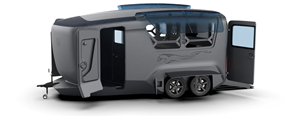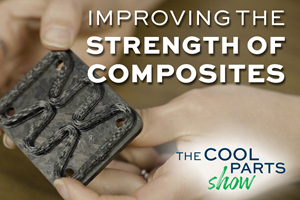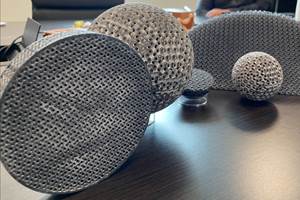9T Labs, Purdue Partner to Advance Composite Use in Structural Aerospace Applications
The collaboration is working to define a new composite manufacturing standard that enables users to produce structural composite parts as easily as metal parts.
Share
9T Labs is collaborating with Purdue University to research and test the potential of manufacturing structural aerospace composite applications at scale with 9T Labs’ additive fusion technology (AFT). This partnership with Purdue, one of the leading engineering universities in the U.S., is a first-of-its-kind U.S. collaboration for 9T Labs, which has expertise in digital, automated and cost-competitive serial production of continuous fiber components.
This hybrid solution combines high-resolution additive manufacturing (AM) with the speed of bulk molding compound (BMC) overmolding to automate manufacturing. It is being developed to offer a cost-competitive option versus the traditional production of aluminum aerospace parts. 9T Labs says its approach to continuous fiber, 3D printed preform parts has already shown great promise in the transportation, medical and robotics industries, among others.
Purdue University’s Composite Manufacturing and Simulation Center (CMSC) in West Lafayette, Indiana, provides the necessary tools and resources to analyze, simulate and test the performance of composites. 9T Labs and Purdue worked collaboratively to develop the application workflow to efficiently engineer and manufacture high-performance parts using BMC chips and continuous-fiber 3D printed preforms. Initial testing shows that customized, continuous-fiber hybrid parts can be digitally designed, 3D printed and co-molded with BMC materials, ensuring performance at only a fraction of the usual cost of continuous fiber materials.
“Traditional composite manufacturing is expensive, wasteful and limited in its geometric freedom, particularly for small-sized applications,” says Yannick Willemin, head of marketing and business development, 9T Labs. “We are defining a new composite manufacturing standard that allows us to produce structural composite parts as easily as metal parts. Our new partnership with Purdue University is a meaningful step toward making this technology more broadly available and accessible within the next 12-18 months.”
The origins of this partnership trace back to when 9T Labs’ CEO and Co-founder, Martin Eichenhofer, learned of John L. Bray distinguished professor of Engineering at Purdue University, Dr. R. Byron Pipes', work on composites during his doctoral studies. “When I heard about the new Composite Manufacturing and Simulation Center led by Dr. Byron Pipes, I reached out to him to discuss what we were doing at 9T Labs,” Eichenhofer says. “His curiosity was piqued and we discovered an opportunity to work together on advanced thermoplastic composites.”
Beyond the practical applications and potential that the AFT hybrid solution brings to multiple important industries, there are strong economic and sustainability benefits to using this technology. “We’ve chosen to collaborate with 9T Labs because we believe that their development of AFT and their novel hybrid approach is the future of the composite manufacturing industry,” Dr. Pipes says.
The combination of zero-waste approach, the possibility to recycle thermoplastics, and the positive impact on part performance being at least 50% lighter than the metal benchmarks makes AFT a very attractive standard of manufacturing.
“This technology we are developing with 9T labs for molding BMC material systems with a relatively small fraction of continuous-fiber printed preforms offers significant potential to enhance the strength performance of molded components without compromising manufacturing rates,” says Dr. Eduardo Barocio, assistant director for additive manufacturing at Purdue.
9T Labs is at the forefront of a completely new field of composite manufacturing that has real- world implications for structural and processing simulation, material compositions and characterization, experimental testing, and application engineering. “This new partnership with Purdue is an additional step toward building a consortium of partners from academia and industry to penetrate the market and accelerate the adoption of AFT and composite materials for a broad application field,” Eichenhofer says.
- Read about how 9T Labs’ deposition process places continuous carbon fiber only where necessary to save material, reduce waste, and more precisely control the structure of preform composites.
- In this episode of The Cool Parts Show, AM editors explore a new way of manufacturing a bracket for a helicopter door hinge, and similar small parts today made from metal.
Related Content
Next-Gen Horse Trailers to Be Built With Robotic 3D Printing
Double D Trailers is currently developing a prototype horse trailer that will be made with large-format additive manufacturing. The technology brings potential benefits for labor, weight and design features to this subset of recreational vehicles.
Read More3D Printed Preforms Improve Strength of Composite Brackets: The Cool Parts Show Bonus
On this episode, we look at a pin bracket for the overhead bin of an airplane made in two composite versions: one with continuous fiber 3D printed reinforcements plus chopped fiber material, and one molded from chopped fiber alone.
Read MoreBetter, More Compact Radio Frequency Devices Through 3D Printing
3D printing technology company Fortify is applying its photopolymer process and material developed with Rogers Corporation to serve the expanding RF market.
Read MoreSavage Automation Delivers 3D Printed Commercial Manufacturing Aids
The company's approach to designing end-of-arm tooling and other devices has evolved over the years to support longevity and repairs.
Read MoreRead Next
Alquist 3D Looks Toward a Carbon-Sequestering Future with 3D Printed Infrastructure
The Colorado startup aims to reduce the carbon footprint of new buildings, homes and city infrastructure with robotic 3D printing and a specialized geopolymer material.
Read MoreCrushable Lattices: The Lightweight Structures That Will Protect an Interplanetary Payload
NASA uses laser powder bed fusion plus chemical etching to create the lattice forms engineered to keep Mars rocks safe during a crash landing on Earth.
Read MoreProfilometry-Based Indentation Plastometry (PIP) as an Alternative to Standard Tensile Testing
UK-based Plastometrex offers a benchtop testing device utilizing PIP to quickly and easily analyze the yield strength, tensile strength and uniform elongation of samples and even printed parts. The solution is particularly useful for additive manufacturing.
Read More





















